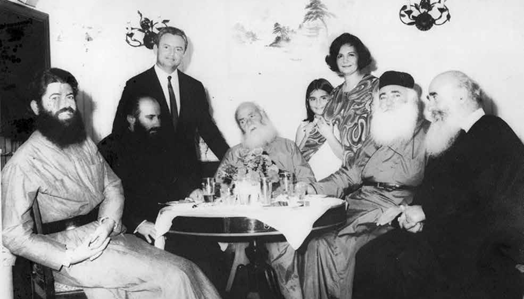Saints Olga and Vladimir, the Enlighteners of the Russians
Saint Olga was born at the end of the 9th century AD and came from a noble family. Both her beauty and her intelligence attracted the ruler of Kiev, Igor, whom she married. Olga, as a Christian, although her husband remained a pagan, attempted to spread Christianity in various ways, even building temples such as Hagia Sophia. In 945 AD, her husband was assassinated and she took over the reigns of the country until her young son Sviatoslav, her heir to the throne, had come of age. During this time she pursued the evangelization of her country. She took a keen interest in strengthening relations with the Byzantine Empire, to the point that in 957 AD she visited Constantinople and very likely would have been baptized by the Patriarch at that time, had this not happened earlier. Her attempt to have her son baptized and follow Christian principles failed. However, she sowed the seed which blossomed after her death in 968 AD in the heart of her grandson Vladimir. O grandmothers, blessed with your modesty, the offering and the censer! O grandparents, who accompany your children and grandchildren to the church door, to vespers and the Divine Liturgy! And you, parents, fighting the “good fight”, the fight of faith… Experiences we ought to leave to those who follow behind us! Experiences that radiate eternal Life, like those of Saint Olga in Saint Vladimir. I wonder, is there a higher quality and more effective mission than bequeathing spiritual experiences to our descendants? Vladimir, before he converted to Christianity, as ruler of Russia (980 AD) was an extreme pagan. He moved with hostility against the faith of Jesus and harshly persecuted Christians. He built statues and participated in pagan events. However, the figure of his grandmother did not leave him indifferent and unaffected, as mentioned above, a fact that is subsequently proven by his life. Vladimir did not rest in idols, in the power murders he committed and in the obscenities in which he fell into with the hundreds of concubines he had, just as, moreover, a man who knows the law of God does not rest in a life of sin. He was tormented, in a good sense, by the truth his grandmother taught him! On the other hand, he wanted, free spirit that he was, to examine and learn about the religions of the neighbouring countries of his empire. So he sent a delegation of officials of his state with the purpose of investigating and discovering, if any, the true faith. The Muslim religion disappointed the emperor’s representatives, the Jewish religion did not interest them, nor did the faith of the Germans. On the contrary, the Divine Liturgy in the impressive and imposing Hagia Sophia forced them to confess the extraordinary experience they had had, exclaiming that they did not know whether they were in heaven or on earth. Vladimir accepted the opinion of his envoys and decided to convert to Orthodoxy.
Before his marriage to Princess Anna, sister of the Emperor of the Byzantine Empire Basil, around 988 AD, he was baptized a Christian and then the sacrament of marriage was celebrated. He concluded political and military treaties with Emperor Basil and returned to Kiev with many priests to baptize the inhabitants of his country. He tore down pagan statues and almost banned their wild customs, abolished slavery and expanded his charitable activity. Many people claim that the reasons for St. Vladimir’s conversion to Christianity, like those of Constantine the Great, were purely political. This would be true if the two saints had not radically changed their way of life… But the barbarian murderer was transformed into a lenient ruler, the prostitute with hundreds of concubines into a one-woman man, the self-centred king into a philanthropic and merciful ruler. The truth is that there were political consequences of a conscious repentance, a fact evidenced by his later holy life. In a short time, temples, monasteries, charitable and social institutions were built in his country. Saint Vladimir died on July 15, 1015 AD.

Mission and ethno-racialism
On the occasion of our study of saints who, on the one hand, connected two peoples with unbreakable bonds of faith (mother and daughter) and on the other hand were political figures and loved, as history has shown, both their faith and their homeland, we will make a brief reference to two such contradictory concepts, the Mission and (ecclesiastical) ethnophilism. It is Jesus Christ himself who abolished ethno-racialism in his command to the Apostles: “Make disciples of all nations” (Mt 28: 19). He, as the true father of all nations, approached the Samaritan woman. He, revealed to Paul so that he might proclaim: “For ye are all the sons of God through faith in Christ Jesus: for as many as are baptized into Christ, ye have received Christ. No Jew or Greek, no slave or free, no male or female, no male and female; for all of you are in Christ Jesus” (Gal. 3:26-28). What does ethno-racialism have to do with missions? They are diametrically opposed concepts. Mission is the spreading of the ecumenical Gospel to humanity, whereas ethno-racialism is the shrinking and confining of the ecumenical message of the Gospel to geographical, racial and narrow national boundaries and attitudes of each country. Ethno-racialism is a plague on the body of Christ, the Church. In conclusion, without of course seeking to fully analyze the problem of ethno-racialism, I close my eyes and imagine the ecumenical paradise and more specifically the holy queens Olga and Helen, the emperors Saints Vladimir and Constantine, Saints Seraphim of Sarov and Paisios the Athonite before the throne of Christ and pray: “O God, make Thy Church Militant as Thy Church Triumphant!”





